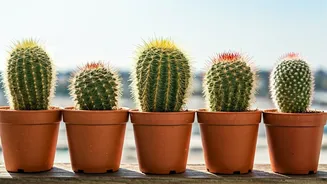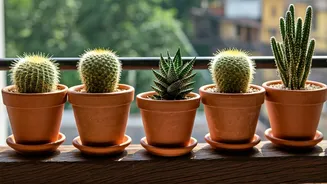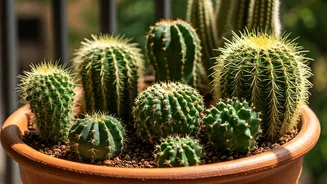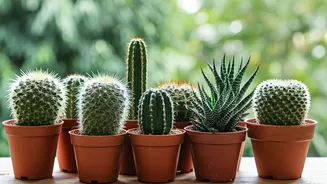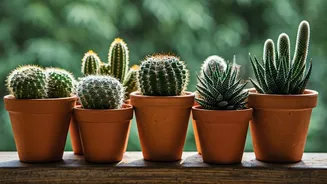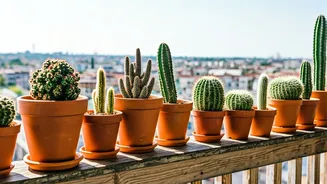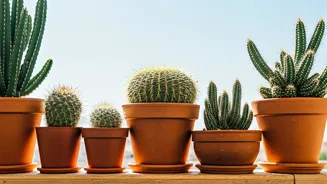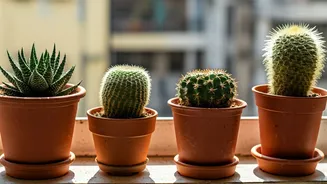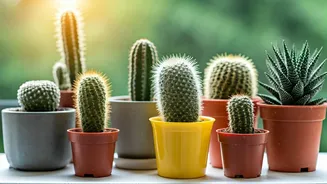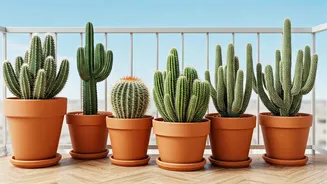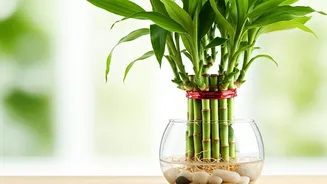Introduction to Cacti
Cacti, known for their ability to survive in harsh, arid climates, are surprisingly adaptable to indoor environments. Their unique structures and low water
requirements make them ideal for balcony gardens, where space might be limited, and conditions can vary. These plants store water in their stems, which allows them to endure long periods without moisture, making them low-maintenance choices. Choosing the right cacti for your balcony involves considering factors such as sunlight exposure, temperature fluctuations, and personal preferences regarding aesthetics. Certain varieties are particularly well-suited for indoor settings due to their compact size and tolerance for less direct sunlight. By selecting appropriate cactus species and providing them with proper care, you can create a vibrant, green oasis on your balcony that requires minimal effort.
1. Opuntia Varieties
The Opuntia genus, commonly known as prickly pear cacti, offers several varieties suitable for balconies. These cacti are recognizable by their flat, pad-like segments and often produce vibrant flowers. Opuntias are relatively easy to care for, requiring ample sunlight and well-draining soil. Their resilience makes them a popular choice for beginners. For balcony gardens, consider the smaller varieties of Opuntia, which can thrive in containers and adapt well to fluctuating temperatures. One of the key aspects of caring for Opuntia is ensuring the soil does not retain excessive moisture; overwatering can lead to root rot. When planting Opuntia in pots, use a cactus mix to provide optimal drainage. Regular watering during the growing season and occasional fertilization are also beneficial, contributing to the health and longevity of these fascinating plants.
2. Mammillaria Cacti
Mammillaria cacti, with their diverse shapes and sizes, present a charming addition to any balcony garden. These cacti are often characterized by their nipple-like tubercles, from which spines and flowers emerge. Mammillarias are generally small and compact, making them ideal for container gardening. They prefer bright, indirect sunlight, which means they can thrive even if your balcony does not receive direct sunlight for extended periods. One of the appealing aspects of Mammillaria cacti is their prolific flowering. They can produce a profusion of colorful blooms, adding beauty to your outdoor space. Like other cacti, Mammillarias need well-draining soil and should be watered sparingly. During their dormancy in winter, watering should be reduced significantly. Proper care ensures they remain healthy and continue to flower, providing continuous visual appeal.
3. Echinopsis Options
Echinopsis cacti, sometimes referred to as sea urchin cacti, include a wide range of species that are well-suited for balcony cultivation. These cacti typically have rounded or cylindrical shapes and boast stunning, large flowers, often blooming at night. Echinopsis thrive in full sunlight, making a balcony with good sun exposure an ideal location. These cacti require well-draining soil and benefit from regular watering during their growing season, usually spring and summer. They are relatively easy to propagate, allowing you to expand your collection. The flowering display of Echinopsis is truly remarkable, with blooms that can last for several days. Proper sunlight, adequate drainage, and controlled watering are critical to encouraging flowering and overall plant health. With proper care, Echinopsis can become a focal point on your balcony, offering a dramatic visual experience.
4. Aloe Vera
While technically a succulent and not a cactus, Aloe Vera is often grouped with cacti due to similar care requirements. This plant, recognized for its medicinal properties, is an excellent choice for a balcony garden. Aloe Vera prefers bright, indirect sunlight and is tolerant of drought conditions, making it perfectly suited for balcony environments. Its ability to thrive on minimal care makes it a low-maintenance option for those with busy schedules. Aloe Vera’s thick, fleshy leaves store water, allowing it to withstand periods of dryness. Regular watering during the growing season, along with ensuring the soil drains properly, will help the plant thrive. The gel extracted from Aloe Vera leaves can be used for soothing skin irritations, adding a practical benefit to its ornamental value. With its versatility and ease of care, Aloe Vera is a great choice.
5. Haworthia Varieties
Haworthia, though slightly different from cacti, are succulents that share similar needs and are well-suited for balconies. These small, slow-growing plants are appreciated for their distinctive patterns and shapes. They thrive in bright, indirect light, making them perfect for areas that receive partial sun. Haworthia require well-draining soil to prevent root rot, and watering should be infrequent, allowing the soil to dry out between waterings. These plants do well in compact spaces and come in various textures, adding visual interest to your balcony garden. Their low maintenance needs and ability to tolerate neglect make them perfect for beginner gardeners. Regular care ensures they maintain their shape and vibrant colors, contributing to an attractive and easy-to-manage balcony garden.
6. Caring for Cacti
Regardless of the variety, several care practices are crucial for all balcony cacti. Ensuring proper drainage is the first step; use a cactus potting mix designed for this purpose. Watering should be done sparingly, allowing the soil to dry out completely between waterings to avoid root rot. Provide ample sunlight, but be cautious of direct, intense sunlight, especially during the hottest parts of the day. Fertilization, performed during the growing season, supports healthy growth. Protect your cacti from extreme temperatures and frost, bringing them indoors or providing shelter as necessary. Regularly check your plants for pests or diseases, treating any issues promptly. By following these basic principles, you can provide an environment where your balcony cacti can thrive, adding beauty and interest to your living space. Consistent and appropriate care is key to enjoying the longevity and aesthetic appeal of your cacti.
